Leg banding provides a visible and cost-effective method for identifying geese, allowing easy recognition without handling the bird. Microchipping offers a permanent and tamper-proof solution, ideal for lost or stolen geese, as it requires a scanner to read the unique ID. Choosing between leg banding and microchipping depends on the balance between convenience, security, and budget for effective goose identification.
Table of Comparison
| Identification Method | Leg Banding | Microchipping |
|---|---|---|
| Durability | Can wear out or fall off over time | Permanent, implanted under skin |
| Visibility | Visible externally for quick ID | Requires scanner for identification |
| Cost | Low cost per band | Higher upfront cost for chip and scanner |
| Application | Simple to attach to goose leg | Requires minor veterinary procedure |
| ID Accuracy | Subject to damage or loss | Highly reliable and unique ID |
| Animal Welfare | Non-invasive but may cause leg irritation | Minimally invasive with proper technique |
| Data Storage | Limited to visual numbers/letters | Stores unique digital info |
Understanding Goose Identification Methods
Leg banding remains a widely used method for goose identification due to its cost-effectiveness and ease of visual recognition in the field. Microchipping offers a more permanent and tamper-resistant solution, enabling accurate data retrieval through scanners even when physical markers are lost or damaged. Understanding the benefits and limitations of both leg banding and microchipping helps researchers and wildlife managers choose the most suitable identification technique for monitoring goose populations.
What Is Leg Banding for Geese?
Leg banding for geese involves attaching a small, lightweight ring around the bird's leg, typically made of metal or plastic, which carries a unique identification number or code. This method enables researchers and wildlife managers to track individual geese for studies on migration, behavior, and population monitoring without causing significant distress to the birds. Leg bands are cost-effective, visible from a distance, and provide long-term data, though they may be lost or damaged over time compared to microchips.
How Microchipping Works in Geese
Microchipping in geese involves implanting a tiny RFID chip beneath the skin, usually at the base of the neck, allowing for permanent and unique identification. When scanned with a compatible reader, the chip transmits a unique code that links to the bird's information in a database, ensuring accurate tracking and management. Unlike leg banding, microchipping reduces the risk of loss or damage and provides a reliable method for long-term identification in both wild and domestic geese populations.
Pros and Cons of Leg Banding
Leg banding offers a cost-effective and non-invasive method for identifying geese, allowing easy visual recognition from a distance which is ideal for field studies and monitoring. However, leg bands can cause discomfort, may fall off or become damaged over time, leading to potential loss of identification data. Compared to microchipping, leg banding lacks permanence and security, making it less reliable for long-term or detailed tracking of individual geese.
Advantages and Drawbacks of Microchipping
Microchipping offers a permanent and tamper-resistant method for goose identification, enabling precise tracking of individual birds over their lifespan without the risk of band loss. The technology ensures reliable data retrieval through scanners, enhancing research accuracy and population monitoring. However, microchipping requires initial handling and minor invasive procedures, which may stress the geese, and the cost and need for specialized equipment can limit widespread application in large-scale studies.
Safety Concerns: Leg Bands vs Microchips
Leg banding for goose identification poses risks such as leg injuries, entanglement, and potential infection, which can compromise the bird's health and mobility. Microchipping offers a safer alternative by implanting a small, biocompatible chip under the skin, reducing the likelihood of physical harm and allowing for durable, tamper-resistant identification. While microchips require specialized scanners, their minimally invasive nature and long-term reliability enhance goose welfare and tracking accuracy.
Effectiveness in Goose Tracking and Recovery
Leg banding offers a non-invasive and cost-effective method for goose identification, allowing researchers to visually track and recover individual birds in the wild, though bands can be lost or damaged over time. Microchipping provides a permanent and tamper-proof identification solution with higher recovery rates, as chips can be scanned regardless of weather or visibility conditions, improving long-term tracking accuracy. Combining both methods can maximize effectiveness in goose tracking and recovery by leveraging the visibility of leg bands and the reliability of microchips.
Cost Comparison: Leg Bands vs Microchips
Leg banding for goose identification typically involves lower upfront costs, averaging around $0.50 to $2 per band, compared to microchipping, which can range from $20 to $50 per chip including implantation. Leg bands are reusable and require minimal equipment, reducing long-term expenses, whereas microchips need specialized scanners for reading and potential vet fees for insertion. Although microchipping offers more permanent and tamper-proof identification, the initial investment is significantly higher than leg banding.
Legal and Ethical Considerations in Goose Identification
Legal regulations surrounding goose identification vary by region, with some jurisdictions mandating leg banding for wildlife tracking, while others permit microchipping under strict guidelines to ensure animal welfare. Ethical considerations emphasize minimizing distress and injury, making microchipping a preferred choice due to its minimally invasive nature and reduced risk of physical harm compared to leg banding. Compliance with local wildlife protection laws and ethical standards is essential to balance effective identification and the humane treatment of geese.
Choosing the Best Identification Method for Your Pet Goose
Leg banding offers a visible, cost-effective identification method for pet geese, allowing for quick recognition in flocks without the need for specialized equipment. Microchipping provides a permanent, tamper-proof solution that stores detailed owner information accessible via scanners, making it ideal for lost or stolen geese. When choosing the best identification method, consider your environment, ease of monitoring, and the level of security needed to ensure your pet goose's safety and traceability.
Leg Banding vs Microchipping for Goose Identification Infographic

 petrevi.com
petrevi.com